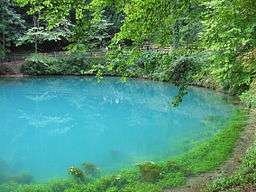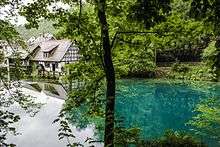Blautopf


The Blautopf (German for Blue Pot; "blau" means blue, "Topf" means pot) is a spring that serves as the source of the river Blau in the karst landscape on the Swabian Jura's southern edge, in Southern Germany. It is located in the city of Blaubeuren, approximately 16 km (9.9 mi) west of Ulm. It forms the drain for the Blau cave system and feeds the river Blau, which after 14.5 km (9.0 mi), flows into the river Danube in the city of Ulm. Because of its high water pressure, the spring has developed a funnel-like shape, which at its deepest point has a depth of 21 metres (69 ft). The water's peculiarly blue color, varying in intensity due to weather and flow, is the result of physical properties of the nanoscale limestone densely distributed in the water. The particles are so small that the so-called Rayleigh scattering of light takes place, preferentially scattering the blue color in the visible light. Similar effect is observed at the Blue Lagoon in Reykjavik, Iceland, where the blue color originates from nanoscale silica particles.
Legends

Numerous legends and folk tales refer to the Blautopf. Its characteristic colour was explained by the account that every day someone would pour a vat of ink into the Blautopf. Another myth stated that every time someone tried to measure the Blautopf's depth with a leaden sounding line, a water nix stole the sounding line. Therefore, it was not possible to determine the depth of the Blautopf. Because of this tale, there is a rock called Klötzle Blei ("little block of lead" in the local dialect) in the vicinity of the Blautopf. A well-known tongue-twister in the Swabian dialect told to local children, refers to this rock:
- Glei bei Blaubeira leit a Kletzle Blei -
- ´s leit a Kletzle Blei glei bei Blaubeira
Standard High German:
- Gleich bei Blaubeuren liegt ein Klötzchen Blei -
- Es liegt ein Klötzchen Blei gleich bei Blaubeuren
English Translation:
- Near Blaubeuren, there lies a block of lead -
- There lies a block of lead near Blaubeuren
The novelist and poet Eduard Mörike incorporated this folklore and other tales into the romantic novella Das Stuttgarter Hutzelmännlein. They were woven into the background story of a journeyman travelling from Stuttgart to Blaubeuren. In particular, the story of the Schöne Lau, a mermaid, and her husband, a male water-nix from the Black Sea, is told in great detail. Because the Schöne Lau could not laugh, the nix punished her by confining her to the Blautopf, and only allowing her to have still-born children. He would only allow her to return and give birth to a living child once she had laughed five times. In the end, the landlady of the inn Nonnenhof came to her aid. (The complete German text is available at Eduard Mörike: Die Schöne Lau.)
Geology

The Blautopf is a spring in a Karst environment. One characteristic of a Karst environment is that water, which drains quickly through the limestone in one area, surfaces in another. Karst environments only have subterranean drainage, and there are no bodies of water above ground. Therefore, the size of the Blautopf depends greatly on the level of rainfall, though it never entirely dries out. The Blautopf is the second largest spring in Germany, after the Aachtopf.
Over millennia, subterranean water has created a huge system of caves in the area. Prominent examples are the Blauhöhle (Blau-cave), discovered by Jochen Hasenmayer in 1985,[1] and the Apokalypse (Apocalypse), discovered on 23 September 2006 by Jochen Malmann and Andreas Kücha, members of the Arbeitsgemeinschaft Blautopf, a club dedicated to the exploration of the Blautopf's cave system.[2] While the Blauhöhle is completely filled with water for a length of about 1500 metres (approximately 4935 ft), the Apokalypse is dry; because of its dimensions—170 metres long, 50 metres wide, 50 metres high—it is a special feature of the region.
Diving in the Blautopf

The entry to the Blauhöhle lies at a depth of about 18 metres (approximately 60 ft). Therefore, access is restricted to experienced and well-trained divers. In the 1980s, city authorities were forced to prohibit diving in the Blautopf after several accidents, including some fatal ones. Permission to dive in the Blautopf has only been granted to a few organizations: among them, the Arbeitsgemeinschaft Blautopf, a group of scientific speleologists led by Jochen Hasenmayer, and rescue services. The most recent fatal accident occurred in 2003, killing Bernd Aspacher, a member of Hasenmayer's team.[3][4]
Attractions
Near the Blautopf is a hammermill fed by the water of the spring. A film, which documents the exploration of the cave, is shown at the same location.
References
- ↑ Schnabel, Ulrich (1 March 1996). "Der Mann im Blautopf (en: "The man in the Blautopf")". Die Zeit (in German) (10). Retrieved 26 July 2013.
- ↑ Raabe, Kristin (12 February 2012). "Tiefenrausch - Manuskript zur Sendung" (in German). Deutschlandradio. Retrieved 26 July 2013.
- ↑ "Blautopf: Taucher kommt uns Leben (en: "Blautopf: Diver is killed")". Schwäbische Zeitung (in German). 29 September 2003. Retrieved 26 July 2013.
- ↑ "Springs of Germany: Blautopf". Jochen Duckeck. 27 December 2011. Retrieved 26 July 2013.
External links
| Wikimedia Commons has media related to Blautopf. |
- Homepage of the Arbeitsgemeinschaft Blautopf (English version available)
- Homepage of the city of Blaubeuren (in German)
- Webpage about the Blautopf with more links
- Film taken at Blautopf
Coordinates: 48°24′57″N 9°47′02″E / 48.41583°N 9.78389°E